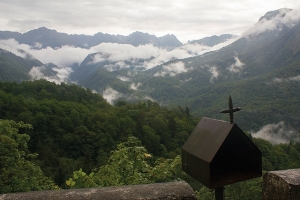Long & Winding Road
Blog
The recent tragedy on the road to Shatili, in which 17 people out of 20 in a large “marshrutka” (minibus) died from an 80m fall, has shaken the nation. I mourn too. The three survivors are in critical condition, and anyway will be severely traumatized by their experience, assuming with prayers that they pull through.
There are a number of roads in Georgia which are scary, to say the least, and I’ve been there and back again on most of them, living to tell the tale. Including this one, not long ago, and the even more precarious one through Tusheti.
I suppose one difference is that I was always travelling privately on those particular roads, not on public transport. I have, though, taken the minivans between Tbilisi and Mestia more times than I can remember, the longest regular public transport trip in Georgia, and survived. Lucky? For the recent Tusheti trip we hired a driver of eight years’ experience, who became a good friend en-route, and was calm and not in a hurry. Marshrutka drivers on long routes, on the other hand, tend to try to get there as fast as possible (in my two decades of experience). They face significant financial pressures, usually doing the job for the money, with extended family to support.
Certain roads in Georgia are dotted with what I long assumed to be postboxes, although usually they are found not very near villages or even visible houses at all. In my early days visiting Svaneti, I was usually not the driver, and we didn’t stop at these “boxes”; so I wasn’t getting a close look at their being door-less, usually with a bottle of something inside. You can see where I’m going with this, can’t you?
Eventually, I asked my friend and usual touring partner, Nodar Aprasidze, why there were post boxes in such unlikely places. After a good laugh, he told me that they are in fact memorial spots for those who died right there, usually in a car accident. You would drink a swig in memory of the deceased and drive on, ignoring the irony of imbibing the same substance implicated in the death(s), and its danger to you as well. And now I have been in Georgia long enough to have known several of the people who are thus remembered, people from my own adopted village in Svaneti, or their relatives.
At least the drinking habits of the Svaneti minibus drivers seem to have been curtailed somewhat in the last decade, compared to the first decade I was here. But their speeds have, if anything, increased, what with better roads extending farther and farther throughout Georgia. One price of speed.
Of COURSE we need better roads, especially where traffic is busy (the main routes across the country, traversed constantly by private cars, public transport and huge numbers of trucks). But also in the places where simple movement is dangerous to one’s life, especially in the mountains. And… making better roads will cause faster traffic, with its own hazards. At least the main road through Upper Svaneti from Jvari to Mestia and beyond has reflector-lit side rails along almost all of its length, making a fall to the depths of the roaring Enguri much less likely. But crashes here involving two or more vehicles at higher speeds might become the more common issue than falls off cliffs.
I suppose these are the growing pains of a developing country, struggling to dig itself back out from its own fall off a high economic cliff (the USSR’s highest per capita income as a Republic to the lowest, post-Soviet). May they be as free of risks, of fatal accidents and the too common scenes of wailing relatives and friends, including me, as possible.
Tony Hanmer has lived in Georgia since 1999, in Svaneti since 2007, and been a weekly writer and photographer for GT since early 2011. He runs the “Svaneti Renaissance” Facebook group, now with nearly 2000 members, at www.facebook.com/groups/SvanetiRenaissance/
He and his wife also run their own guest house in Etseri: www.facebook.com/hanmer.house.svaneti
By Tony Hanmer












